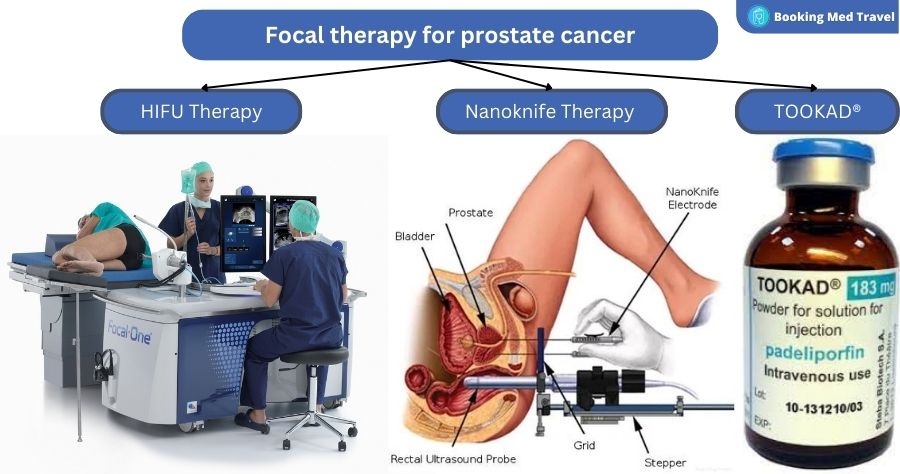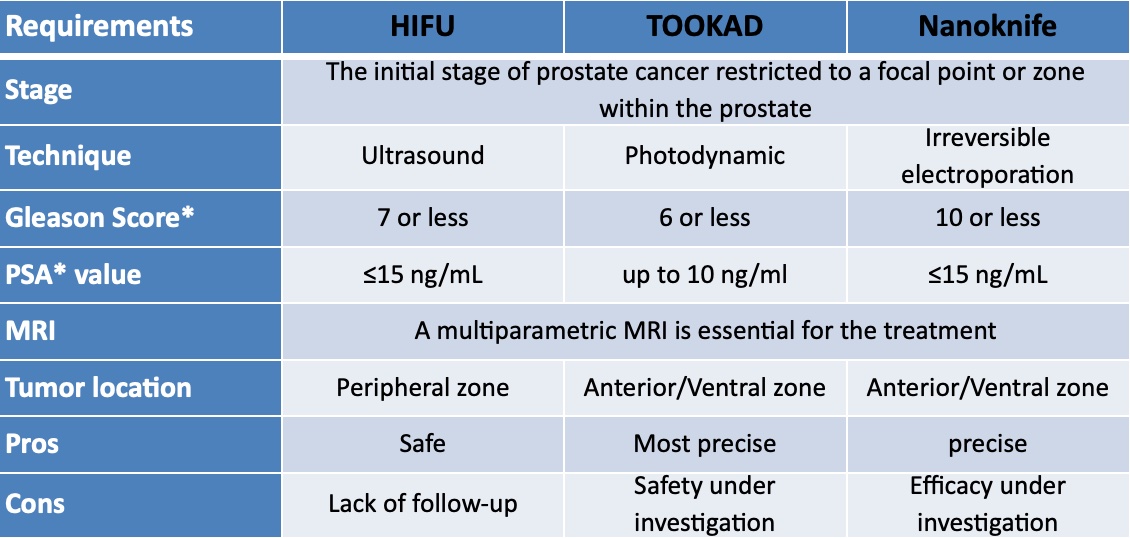
Are you searching for a new selective or focal treatment option for the treatment of early-stage of prostate cancer?
During the initial stage of prostate cancer majority of patients are recommended to undergo a total removal of the prostate gland (i.e. prostatectomy) or radiation therapy as it carries a high probability of cure of cancer or at least a long-term remission but both of these treatments options can lead to major side effects.
Fortunately, with the current advancement in medicine and new diagnostic approaches, it is now possible to detect the tumor in a very early stage where new focal therapies can be applied that allows selective treatment of cancer cells only sparing the healthy prostate cells and nerves. These therapies not only give a high success rate but also lowers the chances of potential side effects
Nevertheless, focal therapies aren't appropriate for all patients due to differences in the overall health of each one. An important criterion to carry on focal therapy is Prostate Specific Antigen (PSA) level which must not exceed 15 ng/ml, or if surgery isn’t a choice due to health-related reasons.
What is focal therapy for prostate cancer?
Focal therapy for prostate cancer consists of removing early-stage prostate cancer lesion without damaging the organ, therefore, reducing side effects, and rehabilitation times in comparison with usual radical treatments.
Different studies showed that localized prostate cancer can be detected with high precision by a multiparametric MRI (i.e. an extra detailed system of MRI) during the initial stage of prostate cancer. The mpMRI in combination with targeted biopsy helps in the early detection of localized prostate cancer, therefore, giving a higher possibility of a focused treatment approach.
Focal therapy for prostate cancer has been improved by mpMRI, and focal ablation of prostate cancer reduced the risks related to whole-gland treatment but there are pros and cons of focal therapy for prostate cancer that are discussed in the next section.
The 3 focal therapies that are used in the treatment of early-stage prostate cancer are High-intensity-focused ultrasound therapy, Vascular-targeted photodynamic therapy with TOOKAD®, and Nanoknife therapy.
Some of these selective therapies are also used in different types of cancer such as breast cancer, renal cancer, and liver cancer.
What are the different types of focal therapies used in the treatment of early-stage prostate cancer?
Focal therapy for the treatment of the initial stage of prostate cancer is developing quickly and different types of therapies have emerged. Overall, following new focal therapies are cited.
1. HIFU therapy
Method: HIFU as in High intensity-focused ultrasound is a method that uses ultrasound technology to produce high-energy sound waves. This later generates high temperatures which are between 58 and 90°C that destroy cancer cells with precision. A transducer amplifies those sound waves exactly like the amplification of sunlight through a magnifying glass which leads to burning a hole in a piece of paper. In focal therapy, the sound waves burn only the tumor foci without damaging the healthy tissue.
Procedure at the hospital: The treatment is carried on under anesthesia, after which the patient is hospitalized and a catheter is placed for 3 to 8 days. Successively PSA value is determined and a control biopsy & MRI are conducted in 6 to 12 months.
2. Vascular-targeted photodynamic therapy with TOOKAD®
In 2017 the EMA (European Medicines Agency) approved photodynamic therapy with TOOKAD as a targeted focal therapy for first-stage prostate cancer. This therapy showed selective tumor destruction with the highest protection of the neighboring healthy tissue.
Method: the therapy uses a combination of light and a drug. Laser beams stimulate a photosensitive drug (TOOKAD) which is administrated intravenously. This activation induces free radical release that will obscure the nearby vessels which results in killing the prostate cancer tissue.
The therapy shows great precision and minor side effects, studies also show by active surveillance that cancer recurrence after two years is lower as well as psychological and emotional relief is achieved. In case of recurrence or tumor progression radical prostatectomy or radiation can still be accomplished.
Photodynamic therapy is promising for primary and post-radiotherapy prostate cancer however, the safety of the treatment needs to be investigated furthermore
Method: Irreversible electroporation (IRE) or Nanoknife is a therapy that uses strong, limited electricity pulses through thin needles in the tumor zone. The electricity generates pores in cancer cells causing their death. The method is highly precise because electricity is easily controlled.
The technology seems accurate, however, data on its efficiency is still uncertain
Which is the best focal therapy for prostate cancer?
Treatment of the first stage of prostate cancer has been improved by the different focal therapies and it is still growing. But which therapy is the best so far?
To answer the question it is important to take into account some factors:
- Cancer location in the prostate
- The surgeon’s expertise in the technique
Those factors are also important in defining the success of the treatment.
Therapies depending on cancer location in the prostate:
- For tumors located in the peripheral zone (which is most common): HIFU method is the most appropriate
- For tumors located in the anterior/ventral zone (which occurs in 10% of tumors): TOOKAD method or the IRE is suitable because it is a zone far from the rectum therefore unchallenging to outreach with those techniques
Nevertheless, it is up to the patient and the doctor together to discuss the most suitable therapy for him
What are the key differences between different focal therapies?

*Gleason Score: A system to grade prostate cancer ranging from 6 to 10, the higher is the score the fast it will spread.
* PSA level: a test to measure prostate-specific antigen in the blood related to prostate cancer.
Advantages of focal therapy for prostate cancer
- Reduced side effects: the foremost advantage of this selective therapy for prostate cancer is reduced side effects such as erectile dysfunction that occurs in 30–90% of patients that undergo surgery or radiotherapy, urinary incontinence, and bowel function problems. Because it’s a therapy that selectively targets tumor foci without damaging the healthy surrounding tissue, those types of side effects are reduced.
- Avoiding overtreatment-related risk: Some patients with low-risk prostate cancer are over-treated, a trial comparing surgery and observant waiting has shown only a decrease of 5% in cancer mortality in 8 years. Focal therapy for localized prostate cancer avoids such risks.
- Enhanced Overall Quality of Life: All studies on quality of life were associated with patient satisfaction. Total gland therapy caused torment in the patient’s life due to urinary and sexual symptoms post prostate-cancer treatment while focal (selective) therapy avoids such complications, therefore, improving the post-therapy quality of life for the patient.
- Cost efficiency: Radical prostatectomy costs in Germany about 20 000 Euros to 35 000 Euros, however, focal ablation is more cost-effective therapy it ranges from 15.000 Euros to over 30.000 Euros
Disadvantages of focal therapy for prostate cancer
- The right candidate for Focal Therapy: The identification of the right patient for focal therapy isn’t an easy task. Prostate biopsy is the usual method for the diagnosis of prostate cancer, which is accurate to a certain extent but still a bad predictor of the degree of the tumor extent, therefore, making it difficult to select the right candidate.
- Diagnostic Tools Problems: Although the latest techniques like endorectal prostate MRI is up to 85% sensitive nonetheless, it is still difficult to diagnose cancer that is placed centrally.
- Functional Outcomes: Focal therapy is known to have low treatment-related morbidities but as is relatively new, the long-term outcomes are not yet established.
- Cancer control: The main criterion for every new treatment is its efficiency in cancer control and the therapies that were tested and proved their efficacy were cryotherapy and HIFU. Focal therapy can efficiently control localized prostate cancer in the average period. Yet, is it sufficient? The question remains unanswered and further comparison trials between the total gland and targeted treatments are needed.
Cost of focal therapies for prostate cancer in Germany
The cost for treatment of the early stage of prostate cancer with focal therapies varies depending upon the type of therapy as well as the hospital and the treating doctor.
Focal therapies for prostate cancer in specialized hospitals range between 15,000- 30,000 Euros. This amount covers the cost of the initial clinical and laboratory examination, the therapy itself, the follow-up examinations, the hospital stay, and the elaboration of recommendations for future treatment.
The cost of each therapy can be found on their respective blogs on our website


Comments